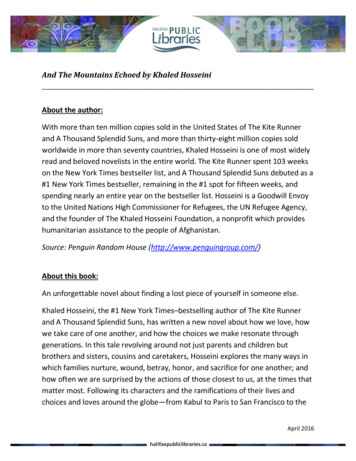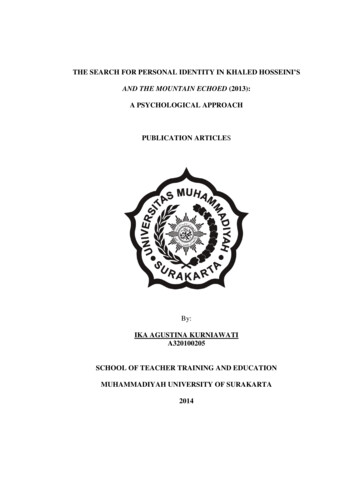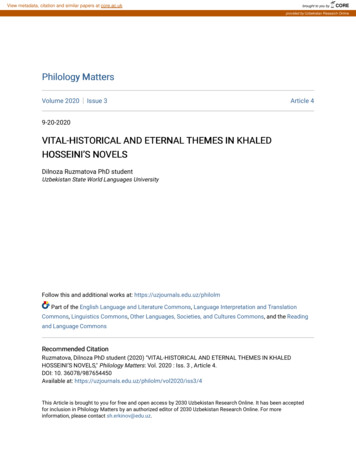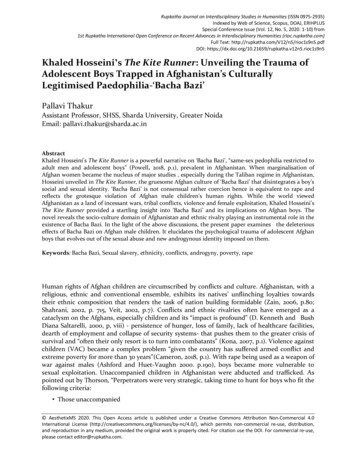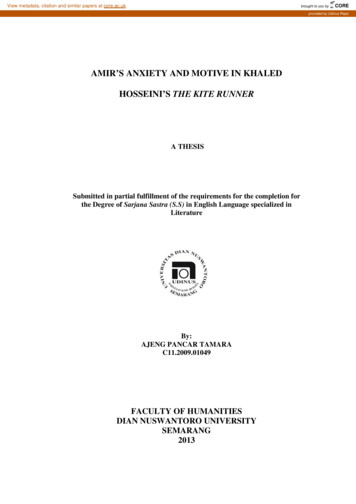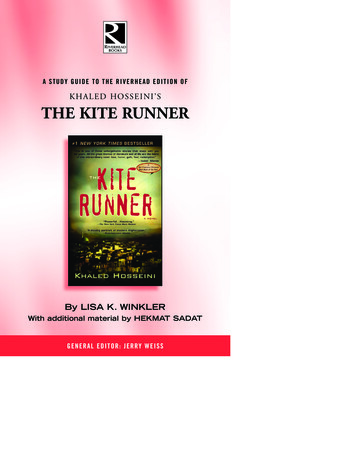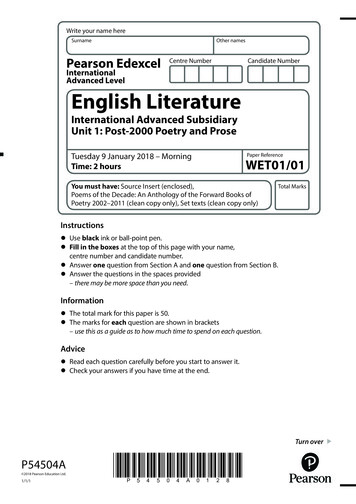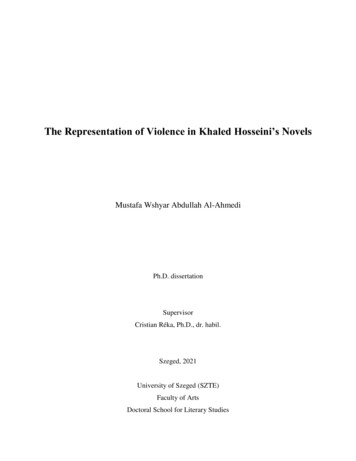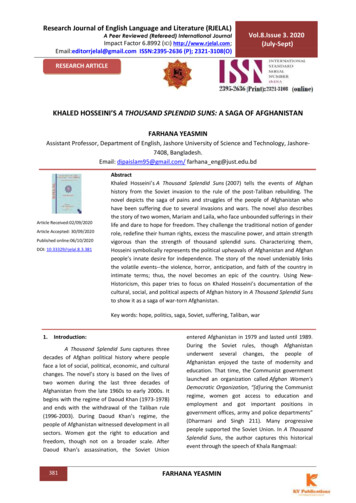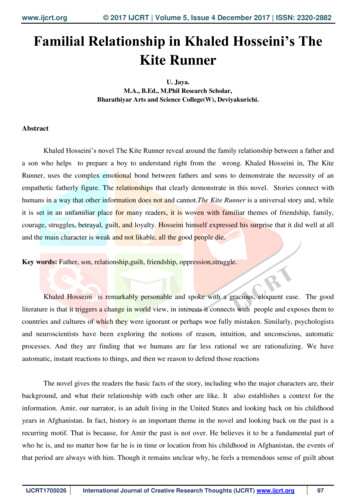
Transcription
www.ijcrt.org 2017 IJCRT Volume 5, Issue 4 December 2017 ISSN: 2320-2882Familial Relationship in Khaled Hosseini’s TheKite RunnerU. Jaya.M.A., B.Ed., M.Phil Research Scholar,Bharathiyar Arts and Science College(W), Deviyakurichi.AbstractKhaled Hosseini’s novel The Kite Runner reveal around the family relationship between a father anda son who helps to prepare a boy to understand right from the wrong. Khaled Hosseini in, The KiteRunner, uses the complex emotional bond between fathers and sons to demonstrate the necessity of anempathetic fatherly figure. The relationships that clearly demonstrate in this novel. Stories connect withhumans in a way that other information does not and cannot.The Kite Runner is a universal story and, whileit is set in an unfamiliar place for many readers, it is woven with familiar themes of friendship, family,courage, struggles, betrayal, guilt, and loyalty. Hosseini himself expressed his surprise that it did well at alland the main character is weak and not likable, all the good people die.Key words: Father, son, relationship,guilt, friendship, oppression,struggle.Khaled Hosseini is remarkably personable and spoke with a gracious, eloquent ease. The goodliterature is that it triggers a change in world view, in interests it connects with people and exposes them tocountries and cultures of which they were ignorant or perhaps woe fully mistaken. Similarly, psychologistsand neuroscientists have been exploring the notions of reason, intuition, and unconscious, automaticprocesses. And they are finding that we humans are far less rational we are rationalizing. We haveautomatic, instant reactions to things, and then we reason to defend those reactionsThe novel gives the readers the basic facts of the story, including who the major characters are, theirbackground, and what their relationship with each other are like. It also establishes a context for theinformation. Amir, our narrator, is an adult living in the United States and looking back on his childhoodyears in Afghanistan. In fact, history is an important theme in the novel and looking back on the past is arecurring motif. That is because, for Amir the past is not over. He believes it to be a fundamental part ofwho he is, and no matter how far he is in time or location from his childhood in Afghanistan, the events ofthat period are always with him. Though it remains unclear why, he feels a tremendous sense of guilt aboutIJCRT1705026International Journal of Creative Research Thoughts (IJCRT) www.ijcrt.org97
www.ijcrt.org 2017 IJCRT Volume 5, Issue 4 December 2017 ISSN: 2320-2882those events and he believes they shaped him into who he is. This guilt, in fact, informs the entire narrative.Appropriately, he opens the novel in the present and then quickly jumps back in time.The author, Khaled Hosseini, spends much more time on characterization than action. In terms ofplot, little happens. Instead, Hosseini introduces us to the personalities of the characters. We learn that Amiris sensitive, bookish, sometimes selfish, and a little mischievous. He is eager to please Baba, whom heviews as a role model he can never live up to. Yet he feels Baba does not love him because he is not likeBaba and because it was during his birth that his mother died. Baba, meanwhile, is gruff, hard working, alittle distant from Amir, and very much an independent thinker. Anytime someone said he would fail, he didnot listen, and he always succeeded. He does not always listen to religious authorities either, evidenced bythe fact that he disregarded Mullah Fatiullah Khan, who said it was a sin to drink alcohol. Ali, meanwhile, isdutiful, modest, and quiet. Lastly there is Hassan, who is a loyal and courageous friend. When Amir isthreatened, Hassan intervenes. He has his own vulnerabilities, however, particularly regarding his mother.Significantly, both Hassan and Amir have lost their mothers. They have only their fathers and each other.The relationship between father and sons, and between the older generation and the new one, is a majortheme story. Also, in many ways Amir and Hassan act for each other as a kind of substitute parent, lookingout for each other and providing companionship. They are closer than regular friends. They are more likebrothers who are on occasion reminded that one is Pashtun and one Hazara. Their relationship plays acentral role in the book, and it figures in another theme that is introduced in this section, standing up forwhat is right. The theme is introduced primarily through Baba, who worries that if Amir could not stand upfor himself as a young boy, he may not be able to stand up for what is right as an adult. He says this becausehe sees Hassan standing up for Amir in fights while Amir appears to back down.Using the characters of Baba and Amir on one side and Ali and Hassan on the other, he lays out of all thedivisions-economic, ethnic and religious-present in the country during the late I970s. Baba and Amir, forinstance, are rich and live in a large mansion, while Ali and Hassan are poor and live in a small hut onBaba’s property. Related is the difference in the health of the rich and the poor, the poor cannot affordproper medicine. Baba and Amir are both healthy, but Ali and Hassan both suffer from problems affectingtheir faces.Baba’s words foreshadow the eventual takeover of Afghanistan by the radical Islamicfundamentalists called the Taliban. “God Help us all if Afghanistan ever falls into their hands, he says, aftercalling Mullah Fatiullah Khan and those like himself –righteous monkeys” (Khaled 17). It will be decadesbefore this happens in the novel, but the political events leading up to the rise of the Taliban, beginning inthe I970s and continuing through 2001, will play a major role throughout the book.IJCRT1705026International Journal of Creative Research Thoughts (IJCRT) www.ijcrt.org98
www.ijcrt.org 2017 IJCRT Volume 5, Issue 4 December 2017 ISSN: 2320-2882The relationship between ordinary people, such as Hassan and Amir, and political events like DaoudKhan’s coup are a main focus of this section. At the beginning of this section, for instance, Amir says in hisnarration that Baba was born in 1933, the same year Zahir Shan became king. The question remain whydoes Hosseini set up this parallel. Because the fates of Zahir Shah and Baba-as well as the fates of thosedependent on Baba, like Amir, Hassan, and Ali-are all bound together in a sense. When Daound khan, in abloodless coup, takes over, we know that the lives of our characters are about to change, even if we aren’tsure how. Amir and Hassan’s encounter with the racist Assef is a hint. The change is not going to be for thebetter. The rules that govern life in Kabul have been stirred up, and power balances have shifted. Bloodshedand violence may be in store. We witness this from the perspective of Amir, a young boy who does notknow what it means that Afghanistan has became a republic. Amir also talks about how prevalent Americanculture was in the country during this time. The movies Amir and Hassan love most are Westerns starringAmerican actors, notably John Wayne and Charles Bronson. The movies are dubbed into Farsi, and the boysspend their money on Coca-cola, one of America’s biggest exports, Baba even drives a black Ford Mustang,which Amir points out is the same car that the actor Steve McQueen drives in the American movie Bullitt.Assef never speaks of just ethnic purity. Assef and others like him are also after cultural purity. Their aim isa pure Pashtu people and culture, and the prevalence of American culture in Afghanistan threatens this goal.As a result, the influence of American culture in Afghanistan will be wiped out almost entirely during theyears that Amir calls the end of Afghanistan as they know it.In fact, the overall theme of thefamilial relationship has a change in politics, society, and in the personallives of Amir and Hassan. For instance, Amir recognizes his gift for storytelling, first when he strays fromthe text he is reading to Hassan and then when he writes his own short story. Hassan also undergoes achange when his cleft lip is repaired. The deformity is something Hassan has known all his life it is, in away, a marker of who he is, a poor servant boy. We can expect things to change between the boys and it isunclear at this point how they will change.The adult Amir, who is telling the story, recognizes several things about his younger self that heevidently did not realize while he was still a boy. He sees that he was selfish, for instance, that he wanted tobe everything and did not want Hassan to be as good. The young Amir genuinely felt that Hassan is beneathhim because of Hassan’s poverty, ethnicity, religion, and deformity. Whenever Hassan does something thatearns Baba’s love and respect, Amir lashes out at him in his thoughts. If Amir knows something Hassandoes not such as vocabulary words, Amir teases him for his ignorance. In each case, Amir recognizes whathe is doing just after the fact and feels guilty. But the reader is led to believe that whatever the event is thatchanged Amir’s life is something he is not able to take back, and so the guilt has haunted him intoadulthood.IJCRT1705026International Journal of Creative Research Thoughts (IJCRT) www.ijcrt.org99
www.ijcrt.org 2017 IJCRT Volume 5, Issue 4 December 2017 ISSN: 2320-2882The reader also sees how the young Amir struggles with his inability to please Baba. This inabilitymakes Amir jealous of anyone else receiving Baba’s attention, which is why Amir became angry anytimeBaba praises Hassan, and again when Baba pays for Hassan is plastic surgery. Amir often finds passiveaggressive ways to take his frustration out on the Hassan, such as mocking his ignorance or his inability toread. Reinforcing the theme of the love and tension between fathers and sons that recurs throughout thestory is Amir and Hassan’s favorite story, Sohrab and Rustom which is about a father that fatally stabs anopponent not knowing until too late that the opponent is his son. For Amir, the story represents hisrelationship with Baba. Complicating Amir’s feelings toward Baba further is his relationship with RahimKhan. Rahim Khan read Amir’s story when Baba would not, giving Amir the attention and approval hecraved, and Amir even wishes at that point that Rahim Khan were his father. The fact is Amir desperatelywants Baba’s approval, yet he has no idea how to get it.Many of the tensions that have been building till now, such as the treatment of Hazara by Pashtuns,Amir’s description to please his father, and question of whether he can stand up for what is right, cometogether in the events of this section. The central event is Hassan’s rape, and it will be the catalyst thatpropels the rest of the novel forward. This event is the source of the guilt Amir feels as an adult, and it iswhy the image of the alleyway, the place where Hassan was raped while he stood by and watched, affectshim. Hassan, we are led to infer, is the kite runner of the book’s title, and Amir tells us the story both as aconfession and an act of penance. He wants to atone for his sins, and in fact atonement will become a majortheme. Two other important themes also converge in the single image of Amir struggling with the decisionto intervene or not while Assef, a rich Pashtun boy with a powerful father, rapes Hassan, a poor Hazara.This image conveys the challenge and importance of doing what is right, and the rape of Afghanistan’spowerless by those who have power.Amir’s character grow, his desperation to please his father, which we have witnessed throughout thestory, plays a significant part in causing the events of the section. Although Amir feels paralyzed by fearwhen he sees what is happening, he admits that his main reason for not intervening is selfishness. WhenBaba was a boy, he won kite-fighting tournament. Though Amir had always done well in the competition,even making it to the final three once, he had never won. To finally please Baba, Amir feels he must showBaba he is like him by winning the tournament and bringing home the kite of his final opponent. Only thenwill Baba forgive Amir for killing the women who was Baba’s wife and Amir’s mother. Amir does not stopAssef from raping Hassan first and foremost because he wants the kite to bring to Baba and Hassan is theprice he has to pay.IJCRT1705026International Journal of Creative Research Thoughts (IJCRT) www.ijcrt.org100
www.ijcrt.org 2017 IJCRT Volume 5, Issue 4 December 2017 ISSN: 2320-2882To sum up,Family is the basic unit in the society in which forms a system as well as the one whichpreserves our traditional and ethical values of our nation. With the basic unit in the society, Khaled Hosseinitakes this as his major theme in his two novels, A Thousand Splendid Suns and The Kite Runner. Familyconsist of husband and father, wife and mother, sister, brother, aunt, uncle, grandma, grandfather, cousins,in-laws and so on. Such a great deal of bond is also revealed in Hosseini’s works. The major bonds of lovein a family shown in his novels are father and son, mother and daughter, woman and woman, Man and Manrelationships. The strong bonds of love shown in the novel A Thousand Splendid Suns is Woman andWoman relationship, Mariam to Laila, Laila to Mariam and in the novel. The Kite Runner is Man to Manrelationship between Amir and Hassan, Hassan to Amir. As a researcher everyone loves his novel for thedetailed description of characters and being a doctor he has described characters minutely to enhance thefeelings of the readers. This is the specialty of the readers Khaled Hosseini’s novels are the bestsellers andalso world is most acclaimed novels for the simple reason The Portrayal of Family in his works. Most of thethemes in his novels are familiar to the readers but the theme of woman to woman relationship and man toman relationship is outstanding and will definitely attract the attention of every researcher.Works CitedBartley, Jim. “Kite Catches and Flies High.” N.p, n.d. Web. 28 June 2003. http://dejantodorovic. wordpress.com .Hosseini, Khaled. The Kite Runner. New York: Bloomsbury, 2003. Print.Noor, Ronny. “Review of the Kite Runner by Khaled Hosseini”. N.p. Web. 05 June 2004. itical-article- summaries/ .IJCRT1705026International Journal of Creative Research Thoughts (IJCRT) www.ijcrt.org101
Khaled Hosseini's novel The Kite Runner reveal around the family relationship between a father and a son who helps to prepare a boy to understand right from the wrong. Khaled Hosseini in, The Kite Runner, uses the complex emotional bond between fathers and sons to demonstrate the necessity of an empathetic fatherly figure.
